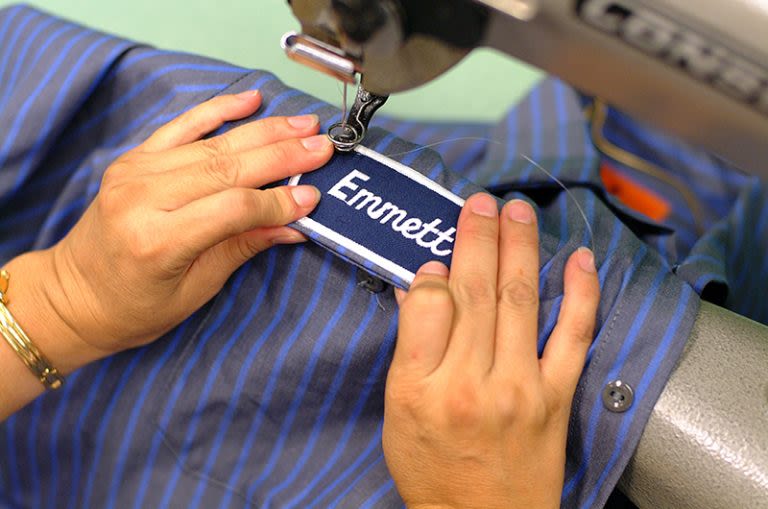
Whether you are sewing a name patch on a breast pocket, a large company logo patch on the back or small patches on the sleeve or collar of a uniform, there are a few different methods to get the job done.
Sewing by hand, using a sewing machine or opting for an alternative way to adhere the patch to the uniform are all good ways to make sure your uniform has the right patches firmly affixed where they need to be.
Prepare the Uniform Before Sewing the Patch
First, no matter which method you choose for sewing your patch onto your uniform, ensure the uniform is properly prepared.
It’s essential to wash the uniform before affixing patches. Most uniforms are made of a cotton blend and may shrink in the wash, especially if washed in hot water and dried on high heat.
To avoid any buckling or puckering around the patch, make sure the uniform has been washed and dried, or preshrunk, before you sew on the patch.
If necessary, iron the uniform before beginning.
How to Sew a Patch on a Uniform by Hand
Sewing on a uniform patch by hand may seem like the simplest solution, but it’s not without pitfalls.
If you’re not careful, it is easy to sew the patch on crooked, get the thread tangled up or break needles because the patch and uniform material are often thick. However, if you don’t have a sewing machine, sewing by hand is the quickest, most inexpensive way to attach a patch.
Here’s how:
Step 1: Gather your supplies.
Collect your washed uniform, the patch you want to attach to it, thread that is the same color as the uniform and/or patch, a needle, scissors, a ruler and pins or tape.
Step 2:
Affix the patch to the uniform exactly where you want it.
Use the ruler to determine exactly where you want the patch, and make sure it is even. Note the shoulders may not be a straight line on all uniforms, so ensure the patch is perpendicular to the vertical button or zipper up the middle of the top.
Using tape, a few pins or a couple of big basting stitches that you will remove later, attach the patch to the spot so it doesn’t move while you sew it.
Step 3: Cut the thread.
Make sure the thread is long enough to go through the needle, so both ends can be tied together to create the knot. This will make the thread double strength and far stronger than a single thread.
Step 4: Create tiny stitches.
Going along the edge of the patch, create tiny stitches. Pull the needle through both the uniform and the patch, and then push the needle back through at almost the same spot. This will create a clean look.
Step 5: Completely encircle the patch in stitches, and tie off the knot.
Tie the knot at the back of the patch when you are done sewing around the perimeter.
Pro tip: If you find that you are continually poking your fingers with the sewing needle while trying to attach the patch to your uniform, try to avoid pushing the needle all the way through the patch. Instead, just push it through the threads on the back of the patch.
You’ll avoid hurting your fingers by jamming the needle through the patch, and you can hide the stitches as well. This means your thread color choice is less important as long as it matches the uniform.
How to Sew on a Uniform Patch Using a Sewing Machine
If you have a sewing machine, the process of sewing a patch to your uniform may be quicker than sewing by hand. However, you will need to make sure your sewing machine is strong enough to handle the job.
You will need strong needles that are thick enough so they won’t break from the rapid movement of the machine and the thickness of the patch and fabric.
You will also need to ensure your thread is strong enough to stand up to the job.
Once you’ve done that, here are the steps to follow:
Step 1:
Gather your washed uniform, patches and matching thread.
Step 2:
Secure the correct foot and needle to the machine, adjusting the tension as needed. Thread the machine.
Step 3:
Perform a practice run on scrap fabric to make sure it works properly.
Step 4:
Secure the patch to the uniform, using the ruler and pins, so it is straight and centered.
Step 5:
Set the needle and foot close to the edge of the patch. Slowly sew around the perimeter, making sure the patch remains centered.
Step 6:
Sew back and forth over a couple of stitches to secure the thread. Trim the threads close to the patch on the front and the back.

Alternatives to Sewing a Patch on a Uniform
Don’t have a sewing machine, but you’re looking for a quick fix? Try one of these alternatives to sewing a patch onto the uniform:
Use fabric glue.
Depending on the placement of the patch, a strong fabric glue may help you to affix it. These often wear off with multiple washings, so be prepared to redo the process frequently.
Iron on the patch.
Though it is recommended to tack down the corners of the patch with a single stitch, you may be able to iron on the patch if it has the right adhesive backing.
Hire a tailor or seamstress.
Many dry cleaners, seamstresses and tailors can sew on the patches you need quickly and professionally.
Decrease Your Uniform Workload
Sewing on patches is a big chore. If you’d like to lighten your workload when it comes to the care and maintenance of your company’s uniforms, contact Alsco.
We can make sure you have fresh, clean uniforms at all times, decreasing the time your business spends cleaning, repairing and replacing uniforms.
Learn more about how Alsco can help you manage your uniform needs when you call for a consult today.
